[English] 日本語
 Yorodumi
Yorodumi- PDB-6puf: Structure of human MAIT A-F7 TCR in complex with human MR1-5'D-5-OP-RU -
+ Open data
Open data
- Basic information
Basic information
| Entry | Database: PDB / ID: 6puf | ||||||
|---|---|---|---|---|---|---|---|
| Title | Structure of human MAIT A-F7 TCR in complex with human MR1-5'D-5-OP-RU | ||||||
 Components Components |
| ||||||
 Keywords Keywords | IMMUNE SYSTEM / MAIT / MR1 / Metablite presentation | ||||||
| Function / homology |  Function and homology information Function and homology informationpositive regulation of T cell mediated cytotoxicity directed against tumor cell target / antigen processing and presentation of exogenous antigen / MHC class I receptor activity / beta-2-microglobulin binding / antigen processing and presentation of peptide antigen via MHC class I / T cell receptor binding / negative regulation of receptor binding / early endosome lumen / Nef mediated downregulation of MHC class I complex cell surface expression / DAP12 interactions ...positive regulation of T cell mediated cytotoxicity directed against tumor cell target / antigen processing and presentation of exogenous antigen / MHC class I receptor activity / beta-2-microglobulin binding / antigen processing and presentation of peptide antigen via MHC class I / T cell receptor binding / negative regulation of receptor binding / early endosome lumen / Nef mediated downregulation of MHC class I complex cell surface expression / DAP12 interactions / transferrin transport / cellular response to iron ion / Endosomal/Vacuolar pathway / Antigen Presentation: Folding, assembly and peptide loading of class I MHC / peptide antigen assembly with MHC class II protein complex / cellular response to iron(III) ion / MHC class II protein complex / negative regulation of forebrain neuron differentiation / antigen processing and presentation of exogenous protein antigen via MHC class Ib, TAP-dependent / ER to Golgi transport vesicle membrane / peptide antigen assembly with MHC class I protein complex / regulation of iron ion transport / regulation of erythrocyte differentiation / HFE-transferrin receptor complex / response to molecule of bacterial origin / MHC class I peptide loading complex / T cell mediated cytotoxicity / positive regulation of T cell cytokine production / antigen processing and presentation of endogenous peptide antigen via MHC class I / antigen processing and presentation of exogenous peptide antigen via MHC class II / positive regulation of immune response / MHC class I protein complex / positive regulation of T cell activation / peptide antigen binding / positive regulation of receptor-mediated endocytosis / negative regulation of neurogenesis / cellular response to nicotine / positive regulation of T cell mediated cytotoxicity / multicellular organismal-level iron ion homeostasis / specific granule lumen / phagocytic vesicle membrane / recycling endosome membrane / Interferon gamma signaling / Immunoregulatory interactions between a Lymphoid and a non-Lymphoid cell / negative regulation of epithelial cell proliferation / MHC class II protein complex binding / Modulation by Mtb of host immune system / late endosome membrane / sensory perception of smell / positive regulation of cellular senescence / tertiary granule lumen / DAP12 signaling / T cell differentiation in thymus / negative regulation of neuron projection development / ER-Phagosome pathway / protein refolding / early endosome membrane / defense response to Gram-negative bacterium / protein homotetramerization / amyloid fibril formation / intracellular iron ion homeostasis / learning or memory / defense response to Gram-positive bacterium / immune response / endoplasmic reticulum lumen / Amyloid fiber formation / Golgi membrane / lysosomal membrane / innate immune response / external side of plasma membrane / focal adhesion / Neutrophil degranulation / endoplasmic reticulum membrane / SARS-CoV-2 activates/modulates innate and adaptive immune responses / structural molecule activity / endoplasmic reticulum / Golgi apparatus / protein homodimerization activity / extracellular space / extracellular exosome / extracellular region / identical protein binding / membrane / plasma membrane / cytosol Similarity search - Function | ||||||
| Biological species |  Homo sapiens (human) Homo sapiens (human) | ||||||
| Method |  X-RAY DIFFRACTION / X-RAY DIFFRACTION /  SYNCHROTRON / SYNCHROTRON /  MOLECULAR REPLACEMENT / Resolution: 1.92 Å MOLECULAR REPLACEMENT / Resolution: 1.92 Å | ||||||
 Authors Authors | Awad, W. / Rossjohn, J. | ||||||
| Funding support |  Australia, 1items Australia, 1items
| ||||||
 Citation Citation |  Journal: Nat.Immunol. / Year: 2020 Journal: Nat.Immunol. / Year: 2020Title: The molecular basis underpinning the potency and specificity of MAIT cell antigens. Authors: Awad, W. / Ler, G.J.M. / Xu, W. / Keller, A.N. / Mak, J.Y.W. / Lim, X.Y. / Liu, L. / Eckle, S.B.G. / Le Nours, J. / McCluskey, J. / Corbett, A.J. / Fairlie, D.P. / Rossjohn, J. | ||||||
| History |
|
- Structure visualization
Structure visualization
| Structure viewer | Molecule:  Molmil Molmil Jmol/JSmol Jmol/JSmol |
|---|
- Downloads & links
Downloads & links
- Download
Download
| PDBx/mmCIF format |  6puf.cif.gz 6puf.cif.gz | 392.7 KB | Display |  PDBx/mmCIF format PDBx/mmCIF format |
|---|---|---|---|---|
| PDB format |  pdb6puf.ent.gz pdb6puf.ent.gz | 306.9 KB | Display |  PDB format PDB format |
| PDBx/mmJSON format |  6puf.json.gz 6puf.json.gz | Tree view |  PDBx/mmJSON format PDBx/mmJSON format | |
| Others |  Other downloads Other downloads |
-Validation report
| Arichive directory |  https://data.pdbj.org/pub/pdb/validation_reports/pu/6puf https://data.pdbj.org/pub/pdb/validation_reports/pu/6puf ftp://data.pdbj.org/pub/pdb/validation_reports/pu/6puf ftp://data.pdbj.org/pub/pdb/validation_reports/pu/6puf | HTTPS FTP |
|---|
-Related structure data
| Related structure data |  6pucC  6pudC  6pueC  6pugC  6puhC  6puiC  6pujC  6pukC  6pulC  6pumC  4l4tS S: Starting model for refinement C: citing same article ( |
|---|---|
| Similar structure data |
- Links
Links
- Assembly
Assembly
| Deposited unit | 
| ||||||||||||
|---|---|---|---|---|---|---|---|---|---|---|---|---|---|
| 1 | 
| ||||||||||||
| 2 | 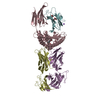
| ||||||||||||
| Unit cell |
|
- Components
Components
-Protein , 4 types, 8 molecules ACBFDGEH
| #1: Protein | Mass: 31711.670 Da / Num. of mol.: 2 Source method: isolated from a genetically manipulated source Source: (gene. exp.)  Homo sapiens (human) / Gene: MR1 / Production host: Homo sapiens (human) / Gene: MR1 / Production host:  #2: Protein | Mass: 11879.356 Da / Num. of mol.: 2 Source method: isolated from a genetically manipulated source Source: (gene. exp.)  Homo sapiens (human) / Gene: B2M, CDABP0092, HDCMA22P / Production host: Homo sapiens (human) / Gene: B2M, CDABP0092, HDCMA22P / Production host:  #3: Protein | Mass: 22781.268 Da / Num. of mol.: 2 Source method: isolated from a genetically manipulated source Source: (gene. exp.)  Homo sapiens (human) / Production host: Homo sapiens (human) / Production host:  #4: Protein | Mass: 27677.760 Da / Num. of mol.: 2 Source method: isolated from a genetically manipulated source Source: (gene. exp.)  Homo sapiens (human) / Production host: Homo sapiens (human) / Production host:  |
|---|
-Non-polymers , 4 types, 2010 molecules 






| #5: Chemical | | #6: Chemical | ChemComp-GOL / #7: Chemical | #8: Water | ChemComp-HOH / | |
|---|
-Details
| Has ligand of interest | Y |
|---|---|
| Has protein modification | Y |
-Experimental details
-Experiment
| Experiment | Method:  X-RAY DIFFRACTION / Number of used crystals: 1 X-RAY DIFFRACTION / Number of used crystals: 1 |
|---|
- Sample preparation
Sample preparation
| Crystal | Density Matthews: 2.78 Å3/Da / Density % sol: 55.71 % |
|---|---|
| Crystal grow | Method: vapor diffusion, hanging drop Details: 100 mM BTP (pH 6.0 - 6.5), 8-20% PEG3350 and 200 mM sodium acetate PH range: 6.0 - 6.5 |
-Data collection
| Diffraction | Mean temperature: 100 K / Serial crystal experiment: N |
|---|---|
| Diffraction source | Source:  SYNCHROTRON / Site: SYNCHROTRON / Site:  Australian Synchrotron Australian Synchrotron  / Beamline: MX1 / Wavelength: 0.9537 Å / Beamline: MX1 / Wavelength: 0.9537 Å |
| Detector | Type: ADSC QUANTUM 210r / Detector: CCD / Date: May 3, 2016 |
| Radiation | Protocol: SINGLE WAVELENGTH / Monochromatic (M) / Laue (L): M / Scattering type: x-ray |
| Radiation wavelength | Wavelength: 0.9537 Å / Relative weight: 1 |
| Reflection | Resolution: 1.92→47.81 Å / Num. obs: 156885 / % possible obs: 99.44 % / Redundancy: 4.6 % / Biso Wilson estimate: 22.39 Å2 / CC1/2: 0.997 / Rmerge(I) obs: 0.1152 / Rpim(I) all: 0.06069 / Net I/σ(I): 10.36 |
| Reflection shell | Resolution: 1.92→1.99 Å / Rmerge(I) obs: 0.6436 / Mean I/σ(I) obs: 1.95 / Num. unique obs: 14872 / CC1/2: 0.291 / Rpim(I) all: 0.3895 |
- Processing
Processing
| Software |
| ||||||||||||||||
|---|---|---|---|---|---|---|---|---|---|---|---|---|---|---|---|---|---|
| Refinement | Method to determine structure:  MOLECULAR REPLACEMENT MOLECULAR REPLACEMENTStarting model: 4L4T Resolution: 1.92→47.81 Å / Cross valid method: FREE R-VALUE
| ||||||||||||||||
| Refinement step | Cycle: LAST / Resolution: 1.92→47.81 Å
|
 Movie
Movie Controller
Controller


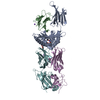
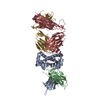


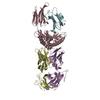

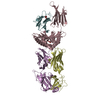


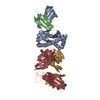
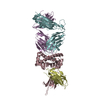


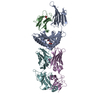

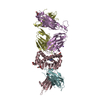
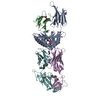
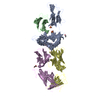


 PDBj
PDBj




